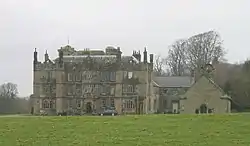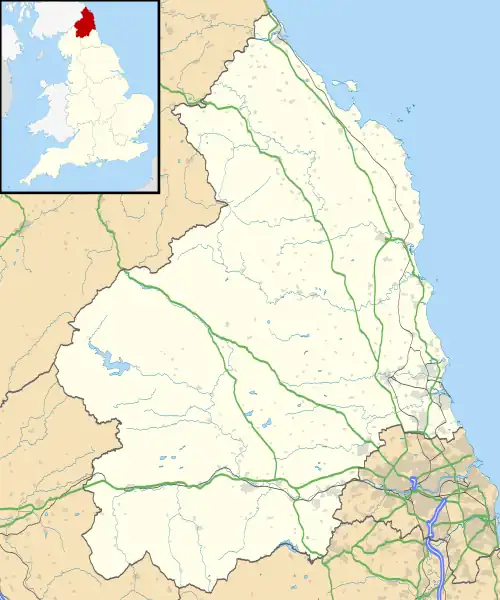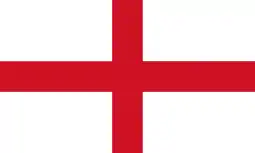| Chipchase Castle | |
|---|---|
| Northumberland, England | |
 | |
 Chipchase Castle Location in Northumberland | |
| Coordinates | 55°04′32″N 2°11′10″W / 55.0756°N 2.186°W |
| Grid reference | NY882757 |
Chipchase Castle is a 17th-century Jacobean mansion incorporating a substantial 14th-century pele tower, which stands north of Hadrian's Wall, near Wark on Tyne, between Bellingham and Hexham in Northumberland, England. It is a Scheduled Ancient Monument and a Grade I listed building.[1]
History
The Heron family acquired the Manor of Chipchase by the marriage of Walter Heron to the Chipchase heiress. He built a massive four-storey battlemented tower house on the site of an earlier house in the mid-14th century.[2][3]
A survey in 1541 described a "fare tower" with a "manor of stone joined thereto" owned by John Heron.[4]
In 1621, Cuthbert Heron (High Sheriff of Northumberland in 1625) demolished the house and built a fine Jacobean mansion, leaving the tower standing and attached to the new house.[3] His first son George was killed at the Battle of Marston Moor in 1644 in the service of Charles I. His second son Cuthbert was created a Baronet by Charles II (see Heron Baronets), but he experienced financial problems which eventually led to the sale of the estate by the Herons to George Allgood, a Newcastle merchant, in 1727.[5]
John Reed, a Newcastle upon Tyne banker, acquired the estate in 1734.[6] Reed carried out major alterations to the castle, including a classical façade to the old tower.[7] The failure of Reed's family bank caused his descendants to sell the estate to the Greys of Backworth in 1821 to defray debts.[8] The Greys then sold the estate to Hugh Taylor in 1861.[9]
Today
The castle is privately owned. It is associated with Paul Torday, the author of the novel Salmon Fishing in the Yemen, which was made into a popular film. He lived there with his second wife Penelope (née Taylor), who inherited the estate, and reportedly did much to help manage it.[10]
The grounds are open to the public but the Castle is open to the public only in June.[11]
References
- ↑ Historic England. "Chipchase Castle (1155161)". National Heritage List for England. Retrieved 30 October 2019.
- ↑ Keys to the Past Archived 2007-09-28 at the Wayback Machine
- 1 2 Structures of the North East Archived 2005-11-02 at the Wayback Machine
- ↑ The Gatehouse Gazetteer, Chipchase Castle
- ↑ Ellwood, Steve (2015). River Tyne. Amberley Publishing. ISBN 978-1445640945.
- ↑ Wills, Margaret (1995). Gibside and the Bowes Family. Society of Antiquaries of Newcastle upon Tyne. p. 62. ISBN 9780850339987.
- ↑ Pevsner, Nikolaus; Grundy, John; Ryder, Peter; McCombie, Grace; Welfare, Humphrey (1992). Northumberland (Buildings of England Series). Yale University Press. p. 231. ISBN 978-0300096385.
- ↑ Welford, Richard (1895). Men of Mark 'twixt Tyne and Tweed: D-J. Walter Scott. p. 382.
- ↑ Transactions of the Natural History Society of Northumberland, Durham, and Newcastle-upon-Tyne. 1877. p. 301.
- ↑ Langdon, Julia (19 December 2013). "Paul Torday obituary". The Guardian. ISSN 0261-3077. Retrieved 27 March 2016.
- ↑ "Chipchase Castle - Weddings - Fishing - Shooting - England, Northumberland". chipchasecastle.com. Retrieved 7 August 2015.
External links
- Images of Chipchase Castle
- Stirnet Pedigree of Heron
- Fry, Plantagenet Somerset, The David & Charles Book of Castles, David & Charles, 1980. ISBN 0-7153-7976-3
